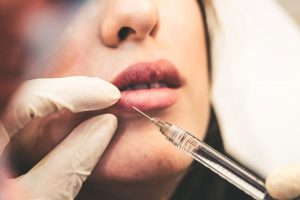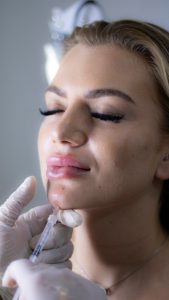 We’ve all heard of Botox before, perhaps you’ve even tried it, but few people know exactly what it is, nor its health effects.
We’ve all heard of Botox before, perhaps you’ve even tried it, but few people know exactly what it is, nor its health effects.
Since it’s accidental discovery in 1987, Botox has drastically advanced in terms of both its approved and off-label uses. For those not familiar with this term – “off-label” means the “unapproved use” of a drug as a treatment for a disease or medical condition which has not been authorised, by for example the U.S. Food and Drug Administration, FDA or Australia’s Therapeutic Goods Administration, TGA. For more information on off-label use of drugs click here.
Botox interestingly was discovered by ophthalmologist Jean Carruthers, MD, and her dermatologist husband Alastair Carruthers, MD when the couple noticed a smoothing and anti-wrinkle effect on the forehead of patients who were being injected with Botox to treat uncontrollable blinking and eye spasms known as blepharospasm. While there are still many medical uses for Botox today, the applications of cosmetic injectables are seemingly endless including minimising crow’s feet, frown lines, to slimming the jawline and reducing the amount of sweat our body produces!
So, What is Botox Exactly?
Botox is an injectable drug made from the botulinum toxin type A, (BoNT-A) which comes from a neurotoxin produced by Clostridium botulinum. Although it does come from the same family of the toxin botulism- a life-threatening form of food poisoning, to reach this level of toxicity one would need to have extremely high levels of Botox injected. Botox therapies only inject a small portion of this toxin into target areas1.
Irrespective, after countless court cases, the FDA has now made it mandatory that Botox has a ‘black box label’ (which identifies the serious safety risks) on it. Black box warnings, also called boxed warnings, are required by the FDA for certain medications that carry serious safety risks. Often these warnings communicate potential rare but dangerous side effects, or they may be used to communicate important instructions for safe use of the drug. For example, several kinds of combination birth control pills carry a black box warning related to cardiovascular risks associated with them.
Botox is an acetylcholine release inhibitor and a neuromuscular blocking agent, which I’ll explain further in a moment, and it is used medically for the treatment of an overactive bladder or urinary incontinence associated with neurologic conditions, for chronic migraines (≥15 days per month with headache lasting 4 hours a day or longer), for upper limb spasticity, cervical dystonia (spasmodic torticollis) and strabismus (a condition in which the eyes do not properly align with each other when looking at an object). There’s no question though that most of us know Botox and its fellow neurotoxins (Dysport®, Jeuveau®, and Xeomin®) to be the most efficacious and popular non-surgical wrinkle reducers in aesthetic medicine.
What’s Involved with Getting Cosmetic Botox?
When it comes to lines and wrinkles, neurotoxins work by temporarily paralysing muscles for cosmetic effect. More specifically – BOTOX (botulinum toxin type A) itself is produced from the fermentation of Clostridium botulinum type A2 and is purified from the culture solution as an approximately 900 kD molecular weight complex consisting of the neurotoxin and several accessory proteins. The complex is dissolved in sterile sodium chloride solution containing human serum albumin and is sterile filtered (0.2 microns) prior to filling and vacuum-drying.
Botox acts as a neurotoxin (a toxin which are destructive to nerve tissue) and works to stop the communication between nerves and muscles. What this means is that prior to Botox, nerves typically tell muscles to contract or move when we want to make certain facial expressions like smiling. The paralysing effect of botulism inhibits the release of acetylcholine, which is the main neurotransmitter at the nerve-muscle junction. When Botox is injected, a blockage is created and the nerves are unable to tell the muscles to make those movements. Therefore, the muscles stay relaxed and the skin on top of the muscle is unable to make undesirable lines or wrinkles on our face. Therefore, by injecting BoNT-A into areas where repeated muscle contractions occur (in-between the middle of the eyebrows, the outer corners of the eyes, and the forehead), the lines, folds, and furrows that would normally etch themselves into the skin are softened.
Using a very fine needle, a doctor injects the Botox directly into the targeted facial muscles and a topical anaesthetic cream may be applied to the skin to decrease the sensation of the injection. Botox treatments take only a few minutes and are given during a typical office visit. The injection feels like a pinprick, with little to no downtime, but the results however are not immediate — initial benefits start to be visible at the five-day mark, with full results at two weeks. Botox then naturally degrades over the course of three to four months, which is why upkeep is essential.
A good question to ask at this point is – “As Botox wears off, where does the product go and how is it eliminated from our body?”
Well depending on where you get your Botox injection it can eventually get into your blood stream and even your lymph nodes which in some cases has been linked to autoimmune disease. The truth is we don’t know when Botox fully leaves our system, or if it actually does. We do know that some people who have had regular injections, get a build-up effect known as Botox resistance (where patients develop an immune response to Botox that reduces the effectiveness of the treatment), and that some people experience damaging health effects months to years down the track.3
Potential Side Effects and Toxic Effects?
If you were to solely consult beauty magazines about Botox, you’d be left thinking it’s a completely harmless and easy cosmetic procedure. This is also the feedback you’d receive from men and women across the world who regularly have Botox. “Sure, there’s a little bruising but there’s absolutely nothing to worry about!” The side effects of Botox are not only played down in the media, but the drug companies and even the doctors themselves giving the injections with many patients saying that their doctors skimmed over the side effects or completely avoided a discussion.
Botox is considered a ‘take at your own risk’ type of drug.3 Even though this drug has a black box label on it, doctors typically take the Botox out of the packaging not the receiver, therefore it’s important that you read up on why Botox has a black box warning for yourself. In fact it’s important that we investigate any drug, surgery, or health procedure (medical or holistic) for ourselves, so that we are fully informed of any of the risks involved.
Some of the common side effects of Botox include2:
- Pain
- Swelling
- Bruising
- Headache
- Chills or Flu-like symptoms
- Fever
- Excessive tearing
- Urinary tract infection/ urinary retention
- Chronic migraine
- Dysphagia (trouble swallowing)
- Upper respiratory infection
- Spasticity: pain in the limbs
A court case where Dr. Sharla Helton, a successful Ob/Gyn and co-founder of a women’s specialty hospital in Oklahoma found herself deathly ill. Dr Helton found herself diagnosed with botulism after her Botox appointment to treat wrinkles in her face. She took Allergan (makers of Botox) to court and won. After her treatment she experienced debilitating weakness and fatigue and become bed ridden. Several months on she could barely walk or get out of bed and from there she was diagnosed with toxic peripheral neuropathy. She eventually had to resign from her job and Allergan had to pay Dr Helton $15 million to cover the cost of her injuries which were a result from their Botox injection.3
A large number of the reported side effects from Botox injections are when an unqualified person administers the botox, or when abnormally high doses and off label procedures are undertaken.
One study involved researchers observing 45 participants over the course of 12 years whereby the participants regularly received Botox injections. During this time, 20 cases of adverse side effects were reported.4
These included:
- Difficulty Swallowing
- Drooping Eyelid
- Neck Weakness
- Nausea
- Vomiting
- Blurred Vision
- General Or Marked Weakness
- Difficulty Chewing
- Hoarseness
- Oedema
- Difficulty Speaking
- Heart Palpitations
New research on how Botox might affect the brain, may bring a frown to even those with the most heavily Botox-ed faces.
A 2015 study collaborated by scientists from the Queensland Brain Institute, Queensland University (UQ) Australian Institute for Bioengineering and Nanotechnology and UQ’s School of Chemical Engineering discovered that for the first time, we’ve been able to visualise single molecules of Botulinum toxin travelling at high speed through our nerves. Dr Wang, a researcher shared that, “The active toxins manage to escape this route and intoxicate neighbouring cells, so we need to investigate this further and find out how. This is concerning for anyone contemplating Botox procedures due to the extreme potency of the toxin.5,7
 Potential Risks and Complications
Potential Risks and Complications
While uncommon these side effects need to be considered:
- The FDA did a study on pregnant rats and found that any level of toxicity from Botox caused reduced foetal body weight and decreased foetal skeletal formation. The doses were also associated with abortion, maternal toxicity, preterm delivery, and maternal death.2
- According to the FDA safety and efficacy are not established in patients under 18 years of age.
- The FDA states, “It is not known whether BOTOX is excreted in human milk. Because many drugs are excreted in human milk, caution should be exercised when Botox is administered to a nursing woman.”
- A common site for injections is in and around the neck to avoid a “double chin appearance.” If the toxin was to spread to the muscles that help you breathe, cough, swallow, this can lead to serious health issues or death.2,6 The risk of symptoms is probably greatest in children treated for spasticity, but symptoms can also occur in adults, particularly in those patients who have an underlying condition that would predispose them to these symptoms.
- If you are allergic to eggs it would be best to stay away from Botox because it is made from an albumin base. You may find yourself breaking out into a rash, hives, puffy eyes, face, throat, and tongue.6
- Back when it was all the rage for celebrities to have Botox injections into their armpits to stop them sweating what they didn’t realise is that the arm pit is the most abundant area for lymph nodes. Lymph nodes are the bodies way of filtering substances through the lymphatic system. Injections here can cause autoimmune disease due to the road they travel in the body and potentially into the central nervous system. Depending where else it is injected can cause paralysis, vision problems, dysphagia (difficulty swallowing). 6
- Depending on where the Botox is in injected you can find yourself with a dropping of the eyelids (ptosis), unsymmetrical eyebrows and distorted smiles. These outcomes occur in up to 5% of people who get Botox injected to their face. 6
The bottom line
Botox is a personal choice, and we encourage you do your research before proceeding. What may be a short-term gain in ridding yourself of physical worry lines, may in time cause you more worry lines. No one can guarantee that using these types of toxins utilised on an ongoing basis aren’t going to tax your health. Everyone has an individual threshold for toxicity, and we live in a world where there are so many familiar and unfamiliar poisons that we are exposed to everyday. It makes sense to avoid or minimise their effects wherever we can.
4 Nutrients Are Better For Your Skin Than Botox!
1. Silica Helps Your Skin Make More Collagen.
Collagen is what keeps your skin tight. Silica is an important mineral that encourages your body to make more collagen and stop toxins that inhibit your collagen production. As you age, your collagen production naturally begins to decline, so this is important.4
2. Biotin Protects Your Skin From Toxins
This B vitamin is involved in the synthesis of fatty acids that are crucial to your skin cells. Your skin cells rely heavily on fatty acid composition to absorb nutrients and push out toxins. Biotin helps them do it.8
3. Selenium Protects Your Skin From Sun Damage
Selenium fuels your skin with potent antioxidants that can protect you from oxidative stress and sun damage. Sun damage, in particular, is often responsible for wrinkles, dry skin, and other skin issues.9, 10
4. Hyaluronic Acid Keeps Your Skin Hydrated
Supplementing with Hyaluronic Acid is one of the most crucial things you can do to keep your skin healthy from the inside out. This is the most important nutrient for skin hydration. When your skin is properly hydrated, it appears supple, youthful, and wrinkle-free.11
In addition to a clean diet and low tax lifestyle, I’d suggest looking further into these nutrients as a safe, viable to keep your skin looking young.
Your’s in Health,
Jennifer Barham-Floreani
(Bach. Chiropractic, Bach. App Clinical Science
Registered internationally, no longer practicing as a chiropractor in Australia.)
References:
1. Hannan C, Cronkleton E. (2018, May 1). Is Botox Poisonous? Here’s What You Need to Know. Retrieved from Healthline: https://www.healthline.com/health/botox-poison
2. FDA. (2011, August ). Black Label Botox. Retrieved from Black Label Botox: https://www.accessdata.fda.gov/drugsatfda_docs/label/2011/103000s5232lbl.pdf
3. Marlowe, M. (2020). The risks and side effects of botox. Retrieved from Clear skin by Marlowe: https://mariamarlowe.com/blog/side-effects-risks-botox/
Mejia NI, et al. (2005). Long-term botulinum toxin efficacy, safety, and immunogenicity. DOI:
10.1002/mds.20376
4. Min-Soo Seo, Y.-I. K.-K.-K.-E.-S.-J. (2019). Comparison study of the response with botulinum toxin muscle injection in the ICR mice from three different sources. Retrieved from BMC: https://labanimres.biomedcentral.com/articles/10.1186/s42826-019-0010-4
5. Team, A. h. (2017, Jan 13). Alot Health. Retrieved from 5 Botox health risks to consider: https://health.alot.com/wellness/5-botox-health-risks-to-consider–2718
6. Tong Wang, S. M.-W.-B. (2015, April 16). Control of Autophagosome Axonal Retrograde Flux by Presynaptic Activity Unveiled Using Botulinum Neurotoxin Type A. Retrieved from The Journal of Neuroscience: https://www.jneurosci.org/content/35/15/6179
7. Yiannakopoulou, E. (2015, Jan 21). Serious and long-term adverse events associated with the therapeutic and cosmetic use of botulinum toxin. Retrieved from PUBMED.gov: https://pubmed.ncbi.nlm.nih.gov/25613637/#:~:text=Serious%20adverse%20events%20included%20dysphagia,Fournier%20gangrene%2C%20and%20cervical%20kyphosis.
8. Gavin, Gertrude, and E. W. McHenry. “The effects of biotin upon fat synthesis and metabolism.” Journal of Biological Chemistry 141 (1941): 619-625.
9. Park, Kyungho. “Role of micronutrients in skin health and function.” Biomolecules & therapeutics 23.3 (2015): 207.
10. McKenzie, R. C. “Selenium, ultraviolet radiation and the skin.” Clinical and Experimental Dermatology 25.8 (2000): 631-636.
11. Papakonstantinou, Eleni, Michael Roth, and George Karakiulakis. “Hyaluronic acid: A key molecule in skin aging.” Dermato-endocrinology 4.3 (2012): 253-258.





